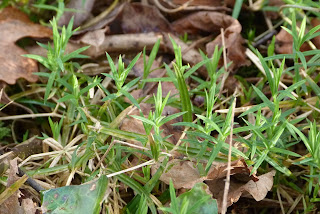As ever, there were more plants to jot down en route: Bird’s-foot
trefoil Lotus Corniculatus leaves barely visible now at the plot,
Creeping
jenny Lysimachia nummular (left) carpeting the wet woodland, Water
mint Mentha aquatica just showing above the flooded woodland edge and Smooth sow-thistle Sonchuss oleraceus around the edge of a small arable clearing next door.
I suspect there's two for the price of one here but can't yet be too sure what the white stuff is behind the King Alfred's Cakes fungus (left) on this sycamore stump ..... possibly Cylindrobasidium evolvens .... but there are two or three very similar fungi? Also found Blushing Bracket Daedaleopsis confragosa on willow at the wet woodland edge.
Just off the bridleway, some fresh stems of Greater Stitchwort Stellaria-holostea. Also came across Kentish Garden snail Monacha cantiana and Pill-bug
woodlouse Armadillidium vulgare, both amongst rubble under my plant benches back at the plot.

And so to pond-dipping: Caught this little Pond skater-like thing which could well be, er ..... a Pond skater Gerris lacustris (?) but it WAS tiny ....
..... and the inevitable Smooth newt Asellus aquaticus as well as a Waterlouse Lissotriton vulgaris or three ...... And just for good measure, I fished two more Common toads out of the cattle trough 'well' inside the barn.

Last but not least, the now essential diversion via the churchyard on the home leg ...... This looks very much like Aspicilia calcarea according to my elderly guide book (and supposedly a limestone lichen) .... but then this was on one of the tombstones ....

Lots of mosses in there too - this looks like Bryum capillare (left) ..... again, according to the good book. And I also managed to confirm Cladonia coniocraea from last week's woodland forage.
But no idea what this one is .... yet ..... on the wall of this ancient church. One or two others still to identify too.
Also added: Hard Fern Blechnum spicant, and Chestnut worm Lumbricus castaneus from around the churchyard .....
Which leaves me stumbling along in the Gibster's slipstream with 220 species.








The pond skater is a mirid bug. Perhaps a Stenodema sp.?
ReplyDeleteThanks Rob. It looks most probably like Stenodema laevigatum now you come to mention it but I wasn't expecting a grass-dweller in amongst the pond stuff. The base of the antenna is certainly different from pond skater and this bug is about half the size too. Can see I'm going to have fun with the smaller inverts ....
DeleteThink your creeping jenny is opposite-lvd golden saxifrage. Bug is one of the Stenodemini as Rob said but wouldn't like to say which.
ReplyDeleteThanks Mark .... I'm going to have to put my glasses on more often when I go out on these ambles round the square. Either that or go back to Specsavers. The bug was just about forgivable (not my strong point) but I ought to have more than one tick deducted for a mistaken plant ID. I now have an unconfirmed orchid - one of six I found on my plot today - which looks like it might be Green-winged (a first here in twenty years) .... can I send you a pic to ID?
ReplyDeleteHi Mike, I'm not going to be much help with your orchid nor many plants really. I only know Opp-lvd GS as I'm still checking them in the hope one day I'll find Alternate-leaved!
ReplyDeleteChurch wall-moss looks like Tortula muralis, Wall screw-Moss
ReplyDelete